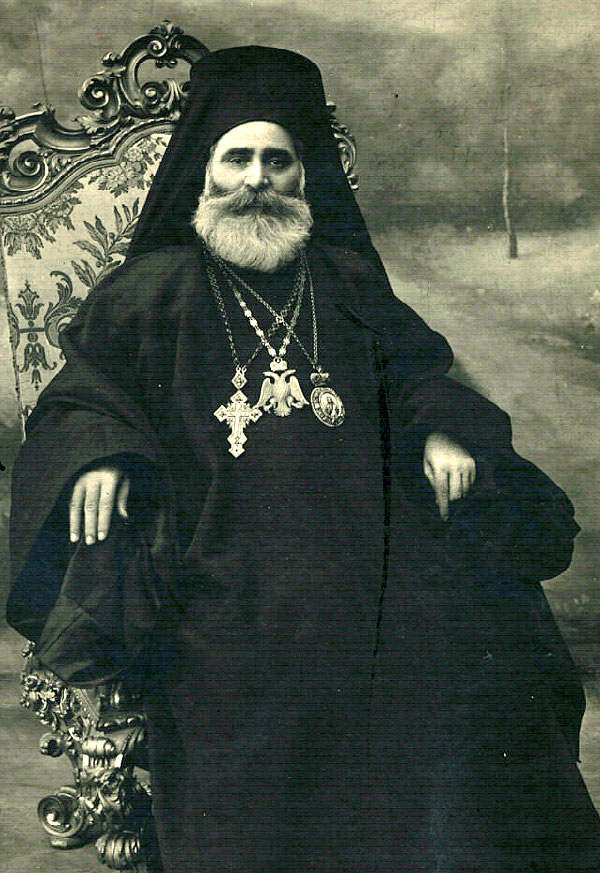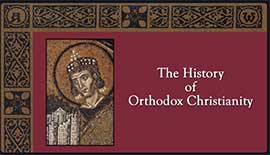MELETIUS WENT FROM ONE LEADING CHURCH POSITION TO ANOTHER

[Above: Patriarch Meletius IV of Constantinople in 1923 (1871–1935)—Wikimedia. Public domain. File:Patriarch Meletius IV of Constantinople.jpg]
BY ANY MEASURE Emmanuel Metaxakis was an extraordinary man. Born in a village on the island of Crete in 1871, he would become an international—and often controversial—figure within the Eastern Orthodox Church. At eighteen he entered the Seminary of the Holy Cross in Jerusalem where he was tonsured [i.e., had his hair cut to indicate he had entered a clerical state] and was ordained as a hierodeacon [“sacred servant”], taking the name Meletius.
In 1900, Patriarch Damianos of Jerusalem assigned him a secretarial role with the Holy Synod in Jerusalem, but eight years later expelled him from the Holy Land on a vague charge of “activity against the Holy Sepulcher.”
Now nearing forty, Meletius was elected bishop of Kition, Cyprus, in 1910. Two years later, he was nominated for the Patriarchy of Constantinople, the highest position in the Eastern Church, but a Holy Synod declared he was ineligible.
Meanwhile, Meletius conducted talks with American churchmen in an attempt to expand relations between the Orthodox and Episcopal Churches. He would have a good deal to do with the Greek Orthodox believers in America after he became Archbishop of Athens in 1918.
His uncle, Eleutherius Venizelos, had fought to free Crete from Turkish control and maneuvered during the Balkan wars of the early twentieth century to more than double Greek territory. Able to force King Constantine from power in 1917, Venizelos deposed Archbishop Theocletos and installed his nephew in his place. Meletius’s mandate (according to a Greek minister, Andrew Mikhalakopoulos) was practically to remake the Greek Orthodox church in a Protestant image.
While archbishop of Athens, Meletius visited America and tried to bring order to its Greek churches which had been under the oversight of Athens since 1908. Meletius appointed Bishop Alexander of Rodostolou as his legate in America. Around this time, he also visited England and engaged in talks aimed at bringing union between the Anglicans and the Greek Orthodox. However, Venizelos’s fortunes changed and with them Meletius’s: King Constantine regained power, and Meletius was ousted as archbishop. He fled to America. Still recognized by Alexander of Rodostolou as Archbishop of Athens, Meletius helped organize the Greek Orthodox Archdiocese of North and South America. During his self-imposed exile, he created controversy by taking part in an Anglican service in Washington, DC, kneeling in prayer, venerating their Holy Table, giving a sermon, and blessing those present.
Two months after his flight from Athens, on this day, 25 November 1921, Meletius was elected Patriarch of Constantinople, as Meletius IV. One of his first acts was to transfer control of the American churches from Athens to Constantinople. He also prevailed on Constantinople’s Orthodox community to accept the validity of Anglican orders. However, his innovations riled many laypeople and conservative clergy who gathered to depose him in 1923. Meletius left Constantinople, claiming illness, and later resigned the patriarchy.
The principle objections to him were that he was a Mason; threatened to erode Eastern Orthodox traditions by seeking closer ties with the Anglican Church and Protestant Episcopal Church; and had invented a pretext to exert authority over America’s Orthodox churches.
Regarding the first complaint, the official website of the Grand Lodge of Greece states Meletius was a freemason in the Apmonia (Harmony) Lodge. As to the second objection, had Meletius been successful in unifying the Greek and Anglican traditions, he may well have caused some changes in Orthodox theory and practice. Regarding the last charge, some Orthodox jurists argue that Meletius had full authority to transfer oversight of America back to Constantinople, based on the 1908 edict of Ecumenical Patriarch Joachim III that had granted Athens temporary control of the American churches. What a patriarch can give, a patriarch can reclaim.
In 1926 Meletius became Patriarch of Alexandria, adding “and all Africa” to his title in place of “and all Egypt.” He would work hard his remaining years to establish Orthodox churches, sees, and missions across the African continent wherever Greek exiles had formed communities. In this he was successful, greatly increasing the Orthodox presence in Egypt and elsewhere. He died in Cairo in 1935.
He was the only man successively to serve as head of three autocephalous (independent) Orthodox Churches: the Greek, Constantinople, and African. He had also shared leadership of a fourth autocephalous church—the Cypriot.
—Dan Graves
----- ----- -----
Learn more about the Orthodox Church in the video, The History of Orthodox Christianity. Watch it at RedeemTV.
The History of Orthodox Christianity can be purchased at Vision Video.







